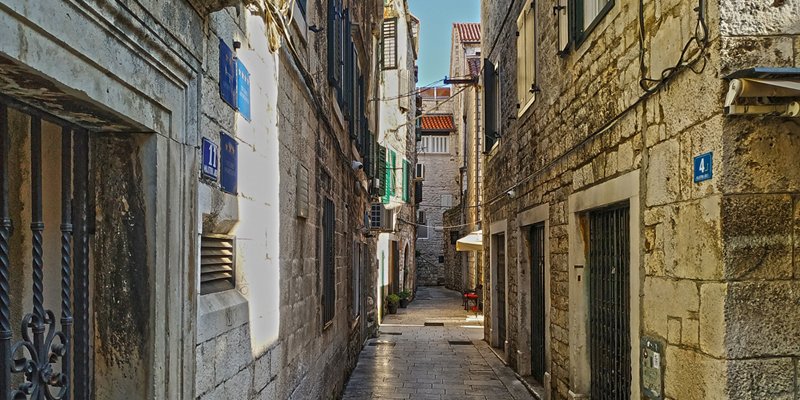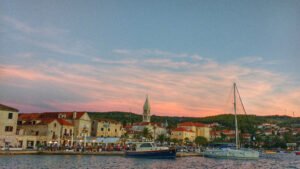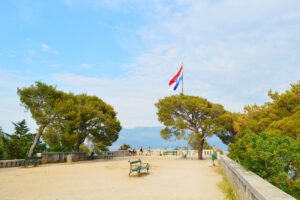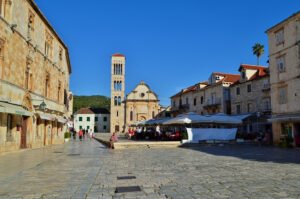Split is a beautiful city known for its rich history, its picturesque Old Town and the stunning views of the Adriatic. But like many seaside destinations, its tourism really only blooms in the warmer parts of the year. Visiting Split in February and March is very much different than visiting it in the peak season in July or August, or, our favorite times, April, May and June. We admit, visiting in the late winter months has its setbacks and is not for everyone. In this short guide, we will try to explain the pros and cons of visiting our Adriatic pearl in February an March.
1. The weather can be a roll of the dice
February and March mark the transition time from the cold winter to warmer spring. The weather in Split is generally mild compared to other parts of Europe, thanks to the warm Mediterranean climate. Temperatures can range from 8°C to 17°C (46°F to 63°F), with late mornings and the afternoons often bringing a pleasant warmth. The weather does, however, often flip-flop between rainy days that usually come with the seaside southern wind jugo or clear, but cool and windy days that come hand-in-hand with the cool northeastern wind bura. There is also a good chunk of days that fall in-between, which are usually warm, clear and windless. Hitting these can be a lottery, but if your stay in town coincides with these, you will be getting the long end of the stick!
2. No crowds… anywhere
One of the biggest differences between visiting Split in February/March versus July/August is the absolute lack of tourist crowds. In fact, your strolls through the mazy Old Town and Diocletian’s Palace will feel almost like a private tour since most of locals tend to hang out in the Riva Promenade during the colder parts of the year. You also won’t need restaurant reservations beforehand, since most restaurants will not be anywhere near full capacity. That is, those restaurants that stay open, because many close their doors come November 1 and remain shut down until April 1.

3. Lower Costs
One of the biggest differences in the off-season is the price of accommodation. The high demand in the peak summer months means that accommodation prices are almost double the price than they are in the off-peak months. Though many apartments and hotels even close their bookings for the winter months, those that do stay open are usually heavily discounted.
Cheaper flights are also a thing, but these can be harder to find since many of the summer lines also stop operating during the winter.
Some restaurants will also have reduced or discounted prices this time of the year, but it really depends on a case-to-case basis.

4. Ferries, boats and tours will disappoint you
One of the biggest side-effects of the off-season is that generally all kinds of transportation options are greatly reduced or stopped entirely. Ferry and fast-ferry lines to the Dalmatian island are heavily reduced and the restless winter seas can lead to cancellations in high-wind times. Inter-city buses, particularly to destinations like Dubrovnik, Plitvice or Krka are limited.
Popular island-hopping tours, private boat charters and water-based activities usually pause entirely due to no demand and unpredictable weather. Even many travel agencies close down during this period so that organized travel tours can be difficult to find.

Things to Do in Split in February and March
If you are lucky with the weather, you will be able to enjoy Split’s labyrinth of narrow streets an ancient walls without the summer crowds. You will still be able to enjoy all the museums, hike on the Marjan Hill, walk the Riva Promenade or shop at the Green Market (Pazar). If you happen to catch bad weather, you can do as locals do and go shopping in one of Split’s shopping centers, attend a basketball or football game, try virtual reality tour or, if in a larger group, even try laser tag.
Getting on day-trips, perhaps the biggest perk of staying in Split, can also be done if you are well-organized. You won’t have much luck with travel agencies, but you can organize your own trips with the available public transport.

You can easily get bus tickets to Trogir, the picturesque medieval town just 30 minutes from Split; Klis Fortress, a hilltop fortress with a stunning panoramic view; Omiš, a charming coastal town with dramatic mountain backdrop that provides a great hiking opportunity; or even Krka National Park.
But you don’t need to stay on land. Ferry lines, though reduced, still operate sufficiently. Particularly lines to destinations closer to Split. You will have trouble travelling to Korčula or Vis for a day, but you will still have enough options to visit closer places like Supetar on Brač and the town of Hvar.
Local Tips for February and March
- Embrace the Slow Pace: Life in Split moves at a relaxed pace, especially in winter and early spring. Take the opportunity to slow down and enjoy long coffee breaks, leisurely meals, and unhurried strolls.
- Learn a Few Croatian Phrases: While many locals speak English, knowing a few basic Croatian phrases like “hvala” (thank you), “dobar dan” (good day), and the handy “bog” (both hello and goodbye) can go a long way.
- Check Opening Hours: Some museums and restaurants may have reduced hours during the off-season. Many restaurants in the Old Town don’t work at all this time of the year It’s a good idea to check their status in advance and to have a short-list of several restaurants at hand.
- Take Advantage of Discounts: As we said, accommodation will be heavily discounted. Why not take the opportunity and book an authentic historic place in the Old Town for fraction of its summer price. Other business might discount their goods, like clothing stores, some restaurants and even bars might run a happy hour. Be on the look out for off-season deals to make the most of your visit
Conclusion
Visiting Split in February and March provides a unique perspective on this historic city. Travel agencies, transportation options and organized tours dry out, but accommodation becomes drastically cheaper.
With the summer crowds gone, you can enjoy a more authentic and relaxed experience. The tourist traps will all be closed and the places that are open will often provide you with a better service and personalized attention due to fewer customers.
For those who dislike crowds, this is the perfect time to visit, as you’ll often find yourself wandering the quiet streets of the Old Town undisturbed. If the weather cooperates, you’ll have the chance to explore the best of Split at a fraction of the usual cost.